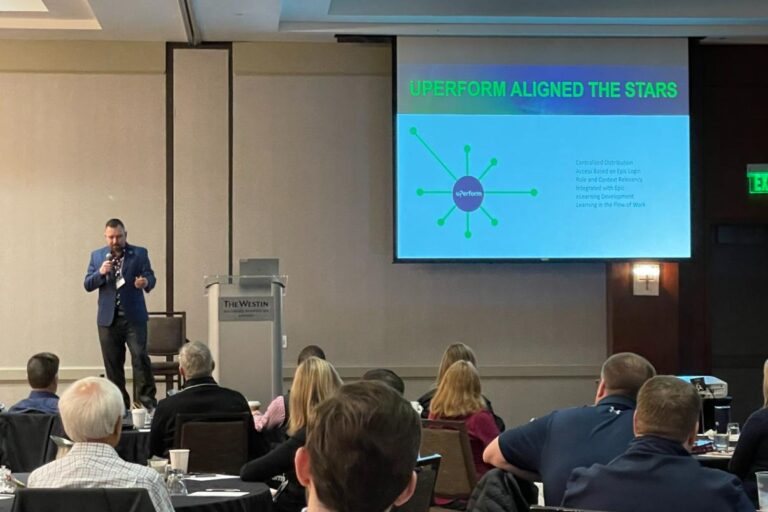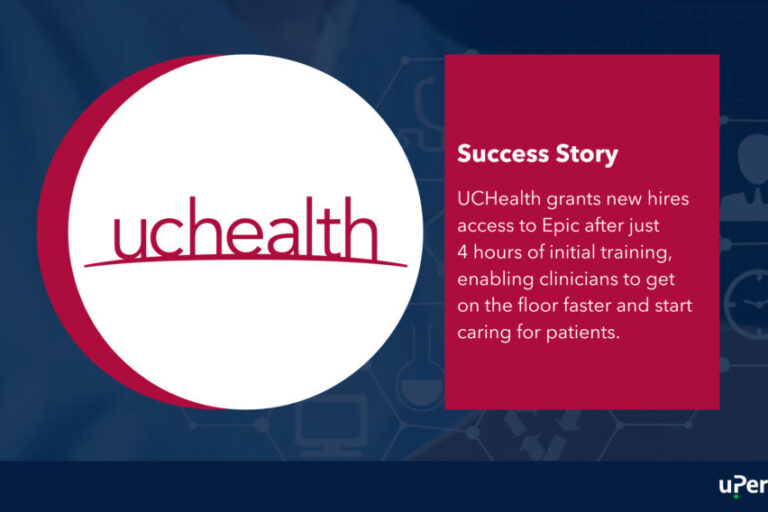Economic hardships and staffing shortages are forcing health systems to find ways to do more with less. In this Becker’s Healthcare podcast episode, Brian Zimmerman sits down with uPerform employees Bobby Zarr, VP, healthcare strategy and Liz Griffith, director of EHR education, as they share strategies uPerform clients are leveraging to streamline and scale training efforts and get clinicians to patient care faster.
Read the synopsis below or tune into the podcast to learn how your training strategy could be “giving back” to your organization by decreasing clinicians’ non-productive hours and increasing their EHR satisfaction.
1. We all know the financial and staffing situations in healthcare are challenging. Why is now the right time for health systems to make technology training a strategic priority?
Although the industry is currently facing heightened economic hardship and clinicians are stressed more than ever before, Bobby and Liz both point out that there’s always been a need for more training. Citing KLAS Research Arch Collaborative data from a 2018 study, Liz points out that even before the pandemic, 57% of providers and nurses were requesting more training. The current challenges only make the need for effective training more pressing than ever before.
Bobby notes that outdated classroom training methods only add to the current challenges healthcare organizations face. The time loss associated with pulling clinicians off the floor is costly. Furthermore, classroom training is difficult to scale for training teams, particularly amid rising turnover and as merger and acquisition activities expand the geographic footprints of health systems.
“Every time somebody turns over, they have to be retrained. That’s a stress on the trainers and the training teams themselves. If you start increasing the cadence of that turnover, you’re going to increase the stress those trainers and training teams.”
2. What efficiencies or improvements are health systems seeing in their training and ongoing support strategies with the help of uPerform?
“I’d say the number one thing is giving time back to the organization,” Bobby emphasizes. Bobby also notes that uPerform clients have seen increased satisfaction among uPerform users. To counter a common misconception that clinicians don’t want to be trained, Bobby clarifies that “…they don’t complain about time spent in training. They complain about how the training was a waste of time. And that’s a big difference.”
Bobby and Liz both stress that training should save clinicians time and meet them where they are. By delivering the right training, at the right place, at the right time, organizations can reduce the amount of time clinicians spend in training while improving user satisfaction with the EHR. Liz adds onto this by sharing how some uPerform clients have been able to save time spent in training so that trainers can shift into a one-on-one coaching role, helping users get the most of the EHR.
3. It seems as though IT education can be overlooked or deprioritized, especially in this current economic climate where resources are limited. How is this trend of deprioritizing technology education impacting the industry as a whole? And how is uPerform helping to reverse that trend?
The deprioritization of IT education is having a significantly negative impact on the healthcare industry, claims Liz. She references another study by KLAS Research that identifies a strong correlation between clinicians who report plans to leave their organization in the next two years and those who are unhappy with their EHR experience and/or IT organization. She stresses that IT organizations need to build strong relationships with the clinicians they serve. Whereas the conversation used to be about asking the question “how do we get clinicians into training?”, now the question must be “how can we get training to our clinicians?” uPerform helps health systems deliver that training to clinicians when and where they need it most – in their workflow.
4. Based on this conversation, we have a good idea of what ineffective training might look like. What does an effective training strategy look like?
“The strategy is really simple. It’s just-in-time…an effective training strategy is meeting the users where they are, when they need it, at the right time, the right place.” For Bobby, an effective training strategy is about delivering training to users within their workflow when they need help. Additionally, content should be offered in multiple formats, so the users can choose their learning mode.
Liz adds that it also requires organizations to rethink their training strategy all together, citing uPerform client UCHealth. Realizing their training strategy didn’t scale to support their growing organization, UCHealth ‘blew up’ their training strategy. This involved working with uPerform to deliver self-paced learning to clinicians and implementing 30-60-90-day follow-ups after onboarding new hires.
While an effective training strategy may vary by organization, Bobby and Liz emphasize that it has to be about meeting the clinicians where they are and providing continuous support throughout their EHR journey.
5. Change can be intimidating. How do health systems get started and how do they make the transition to ‘blow up’ old training paradigms and start new?
“I think the key is taking that first step. It’s like any journey,” says Bobby. Elaborating on that, Bobby stresses that organizations should look at the money they are spending and if it’s being spent effectively. Old training methods tend to be very cost-intensive and only offer so much value.
Bobby uses the example of traditional classroom training to paint a picture: “Think in terms of travel, the training time, the infrastructure cost, the tools they have in place that are redundant, the training is irrelevant, things are not timely…all of that boils down to money.”
Liz adds that organizations should also assess where they are at with regards to clinician satisfaction. What do they like about your current process? What do they dislike? Where are they succeeding and where are they struggling? “Let them help drive that strategy,” she says.












